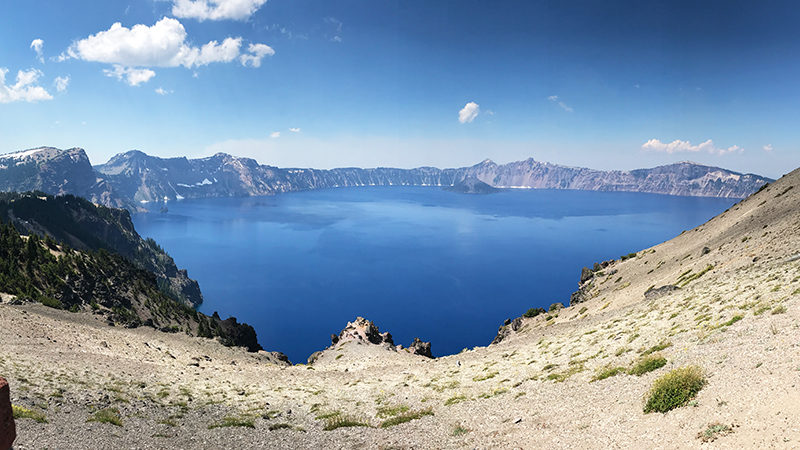
Between Wineglass Viewpoint and Pumice Castle Overlook, just off the scenic Rim Drive around Crater Lake, is Cloudcap Overlook. Cloudcap is an enormous dacite formation covered in pumice from the Mount Mazama eruption that towers nearly 2,000 feet over the surface of Crater Lake rising to 7,960 feet elevation. Like Llao Rock, the older lava flow that created Cloudcap in Crater Lake National Park, filled the crater of an old volcanic explosion.
Cloudcap Overlook sits at the end of a 1.0 mile spur road off Rim Drive — the highest paved road in Oregon leads to the highest Crater Lake overlook.
From the lookout, we enjoyed incredible panoramic views of sparkling Crater Lake. We could see Wizard Island to the west and Mount Scott to the east, and it was out first view of Phantom Ship Island.

Extreme Weather And Flag Trees
Several scenic viewpoints along Crater Lake’s Rim Drive have interpretive signs that provide information about the history and geology of the area. At Cloudcap Overlook signs tell of the extreme weather:
Summers are short, very dry, and moderate in temperature, In winter, storms from the Pacific Ocean drop an annual average of 44 feet of snow, leaving the terrain blanketed in white eight months per year. Prevailing winds blow so strongly from the west that it kills or stunts the growth on the windward side of high elevation tree species. The result is a flag tree, named for it’s flag-like appearance.
In the photo below, you can see the flag trees, with branches only pointing in the direction the wind blows.

Know Before You Go
- Crater Lake National Park, Oregon’s only national park, does not have a physical street address, so it can be hard to locate us using GPS. We made the historic Crater Lake Lodge our first stop, which is located at 565 Rim Drive, Klamath Falls, Oregon 97604.
- At 1,943 feet deep, Crater Lake is the deepest lake in the United States and the principal feature of Crater Lake National Park.
- The 33 mile Rim Drive that travels around Crater Lake’s caldera features spectacular views of the lake and interpretive signage at all of the main vista points.
- Good for seven days, admissions fees are $30.00/vehicle, $25.00/motorcycle in the summer and $15.00/motorcycle in the winter, and $15.00/pedestrian or bicycle.
- The national park is open year-round, 24 hours a day but many of the park’s roads, trails, and facilities are closed seasonally.
- During periods of rain and snow, Crater Lake is often hidden by clouds — it is completely invisible about 50% of the time in the winter!
- Summers at Crater Lake are short but typically sunny. July, August, and September are your best bets for warm, dry weather. However, it can snow any day of the year.
- The park’s North Entrance is closed for about seven months each year. It closes at the first snowfall or on November 1, whichever comes first and reopens in early to mid-summer. The park’s South Entrance and West Entrance are open year-round. We visited the park in late July and the roads had only been open for a week!
- Crater Lake National Park has two visitor centers. The Steel Visitor Center at Park Headquarters is open every day except December 25 — 9:00 am to 5:00 pm from mid-April to early November and 10:00 am to 4:00 pm the rest of the year. The Rim Visitor Center at Rim Village is open daily from late May to late September from 9:30 am to 5:00 pm.
- Dogs on-leash are permitted only in developed areas in the park and in Mazama Village and Lost Creek Campground. Dogs are not permitted on any trails or in undeveloped areas.